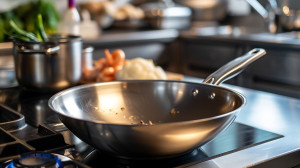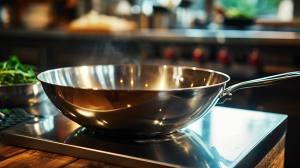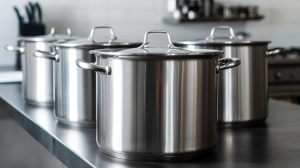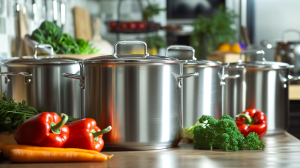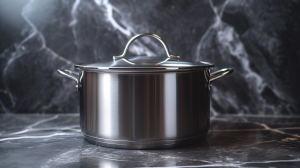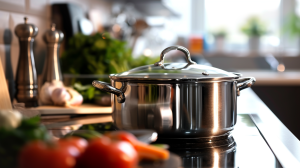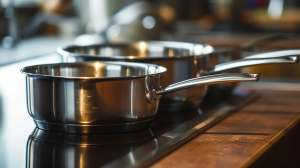Stainless steel is the abbreviation of stainless and acid resistant steel. The steel that is resistant to weak corrosive media such as air, steam and water or has stainless property is called stainless steel; The steel that is resistant to chemical corrosion medium (acid, alkali, salt and other chemical etching) is called acid resistant steel.
Stainless steel refers to steel that is resistant to weak corrosion media such as air, steam and water and chemical etching media such as acid, alkali and salt, also known as stainless acid resistant steel. In practical applications, steel resistant to weak corrosion medium is often called stainless steel, while steel resistant to chemical medium is called acid resistant steel. Due to the difference in chemical composition between the two, the former is not necessarily resistant to chemical medium corrosion, while the latter is generally stainless. The corrosion resistance of stainless steel depends on the alloy elements contained in the steel.

The following are the types of stainless steel. The higher the number, the higher the price.
According to composition, it can be divided into Cr series (400 series), Cr Ni series (300 series), Cr Mn Ni series (200 series), heat-resistant chromium alloy steel (500 series) and precipitation hardening series (600 series).
200 series: Cr Mn Ni
201,202, etc.: manganese is used instead of nickel, which has poor corrosion resistance and is widely used as a cheap substitute for 300 series in China
300 series: chromium nickel austenitic stainless steel
301: Good ductility, used for molding products. It can also be hardened rapidly by machining. Good weldability. The wear resistance and fatigue strength are superior to 304 stainless steel.
302: The corrosion resistance is the same as 304, and the strength is better due to the relatively high carbon content.
303: It is easier to machine than 304 by adding a small amount of sulfur and phosphorus.
304: general model; 18/8 stainless steel. Products such as: corrosion resistant containers, tableware, furniture, railings, medical equipment. The standard composition is 18% chromium plus 8% nickel. It is a non-magnetic stainless steel whose metallographic structure cannot be changed by heat treatment. GB grade is 0Cr18Ni9.
304 L: It has the same characteristics as 304, but is low in carbon, so it is more corrosion resistant and easy to heat treat, but has poor mechanical property, and is suitable for welding and not easy to heat treat.
304 N: It is a nitrogen containing stainless steel with the same characteristics as 304. Nitrogen is added to improve the strength of the steel.
309: better temperature resistance than 304, up to 980 ℃.
309S: It has a lot of chromium and nickel, so it has good heat resistance and oxidation resistance. Products such as heat exchanger, boiler components and injection engine.
310: Excellent high-temperature oxidation resistance, with the maximum operating temperature of 1200 ℃.
316: After 304, the second most widely used steel is mainly used in food industry, clock and watch accessories, pharmaceutical industry and surgical equipment. Molybdenum is added to obtain a special corrosion resistant structure. As it has better chloride corrosion resistance than 304, it is also used as “marine steel”. SS316 is usually used in nuclear fuel recovery devices. Grade 18/10 stainless steel generally conforms to this application grade.
316 L: Low carbon, so it is more corrosion resistant and easy to heat treat. Products such as chemical processing equipment, nuclear power generator and refrigerant storage tank.
321: Other properties are similar to 304 except that the addition of titanium reduces the risk of corrosion of material welds.
347: Stabilized element niobium is added, which is suitable for welding aviation appliance parts and chemical equipment.
400 series: ferritic and martensitic stainless steel, manganese free, can replace 304 stainless steel to some extent
408: good heat resistance, weak corrosion resistance, 11% Cr, 8% Ni.
409: The cheapest model (British and American), usually used as automobile exhaust pipe, is of ferritic stainless steel (chromium steel).
410: martensite (high-strength chromium steel), with good wear resistance and poor corrosion resistance.
416: The addition of sulfur improves the processability of the material.
420: “Tool grade” martensitic steel, similar to the earliest stainless steel such as Brinell high chromium steel. It is also used for surgical knife, which can be made very bright.
430: Ferritic stainless steel, used for decoration, such as automobile accessories. Good formability, but poor temperature resistance and corrosion resistance.
440: High strength cutting tool steel, with slightly higher carbon content, can obtain higher yield strength after proper heat treatment, and the hardness can reach 58HRC, which is among the hardest stainless steels. The most common application example is “razor blade”. There are three common models: 440A, 440B, 440C, and 440F (easy to process).
500 series: heat-resistant chromium alloy steel.
600 series: martensitic precipitation hardening stainless steel.
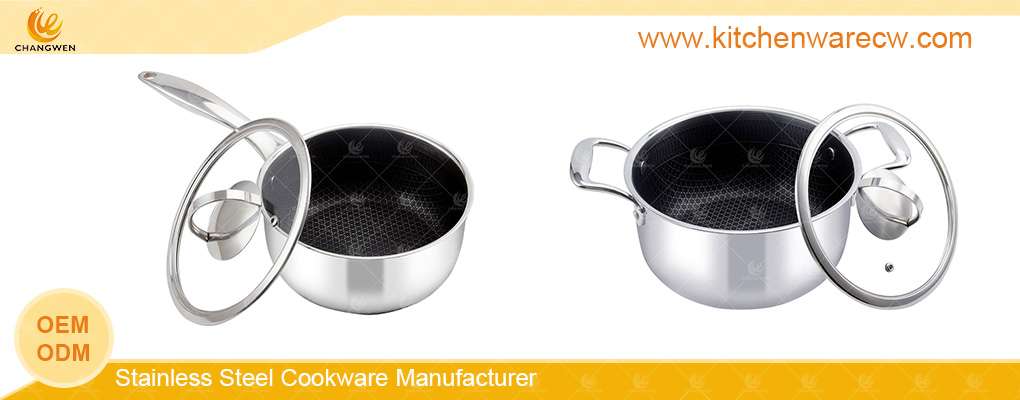
What are the common types of stainless steel pots and pans?
The commonly used stainless steels are divided into five categories and hundreds of brands according to the metallographic structure: austenitic stainless steel, martensitic stainless steel, ferritic stainless steel, duplex stainless steel, and hard precipitation stainless steel.
304,316 stainless steel is suitable for making cookware.
If you choose a normal stainless steel cooker, which is better, 304 stainless steel or 316 stainless steel? I will not hesitate to give the answer: 316 stainless steel contains more rare metal molybdenum (Mo) than 304, which has better corrosion resistance, higher hardness and higher price. Stainless steel 316 is preferred for stainless steel pots.
First of all, if you choose daily non food related appliances, you can directly choose 304 stainless steel, which is relatively cost-effective; If you choose food appliances, such as pots, utensils, bowls and chopsticks, you should try to choose 316 stainless steel. Of course, the use of 304 stainless steel will not cause any harm to people with lower living requirements; For special appliances in medical and instrument industries, it is better to use 316 stainless steel. In addition, it should be noted that when selecting stainless steel food utensils, food grade stainless steel must be selected, that is, with the logo of GB 4806.9-2016.
Introduce 304 and 316 stainless steels
1、304 stainless steel
304 stainless steel is the most common stainless steel brand in our life. Most of stainless steel bowls and chopsticks, spoons and pots are made of this material. This kind of stainless steel has a lot of contact with acid and alkali. Therefore, it has good acid and alkali resistance, high density and beautiful polishing.
2、316 stainless steel
The composition of 316 stainless steel is more than 304 with a rare metal called molybdenum (Mo), which can make 316 have better corrosion resistance than 304. Therefore, 316 stainless steel is generally used in food therapy, machinery, heavy industry or parts making under high temperature environment. Pots made of 316 stainless steel should have better quality and higher price.
3、Comparison
1. Material composition and corrosion resistance
316 stainless steel has a rare element molybdenum (Mo) more than 304, which makes 316 stainless steel much stronger than 304 in corrosion resistance, oxidation resistance and high temperature resistance. For example, common food will not cause corrosion to 304 stainless steel, but some special food, such as carbonated drinks, white vinegar, coffee, etc., 304 stainless steel will go downhill. At this time, 316 stainless steel will be used. This stainless steel added with molybdenum has a much higher corrosion resistance than ordinary stainless steel. It will not be corroded when it is used to hold any food. It is better in terms of oxidation resistance and corrosion resistance.
2. Density and hardness
The density of 316 stainless steel is 8.03 g/cm ^ 3, while that of 304 stainless steel is 7.93 g/cm ^ 3. The density of 316 stainless steel is higher than that of 304 stainless steel. The 316 cooker can better adapt to wear in harsh environments. On the other hand, the plasticity of stainless steel 304 is also stronger, which can be easily made into various daily appliances in life.
3. Price and purpose
316 stainless steel pots and tools are more expensive than 304, about twice as expensive on average, and some are even several times more expensive. Because of its material and price, 304 stainless steel is generally only used for daily life appliances, such as pots and pans, while 316 stainless steel is mostly used in medical, mechanical and other industries, and some food appliances.
4、Suggestions and precautions
First of all, if you choose daily non food related appliances, you can directly choose 304 stainless steel, which is relatively cost-effective; If you choose food appliances, such as pots, utensils, bowls and chopsticks, you should try to choose 316 stainless steel. Of course, the use of 304 stainless steel will not cause any harm to people with lower living requirements; For special appliances in medical and instrument industries, it is better to use 316 stainless steel. In addition, it should be noted that when selecting stainless steel food utensils, food grade stainless steel must be selected, that is, with the logo of GB 4806.9-2016. GB 4806.9-2016 is the national standard for stainless steel tableware, which clearly specifies what standard the stainless steel in contact with food should reach. 304 stainless steel is the lowest grade among the stainless steels that meet the standard.
Conclusion
The above are some of the models of stainless steel and the best ones for making drinking utensils. For more information on how to find a good 316 stainless steel drinking utensil, you can visit Changwen https://www.kitchenwarecw.com/product-category/stainless-steel-cookware/ Learn more.










